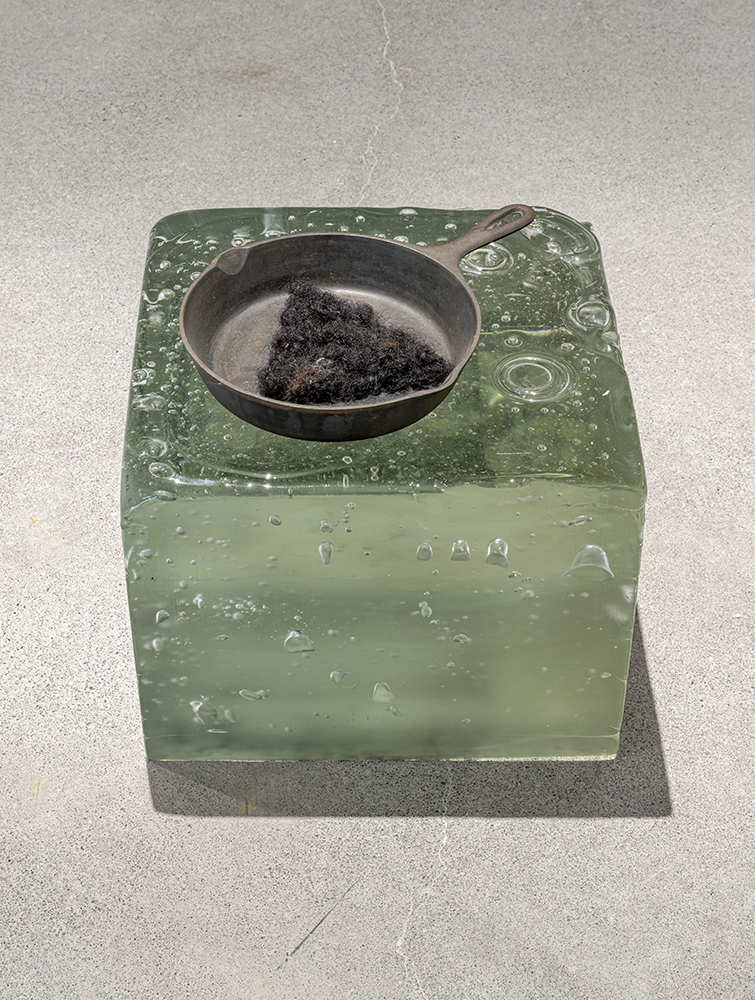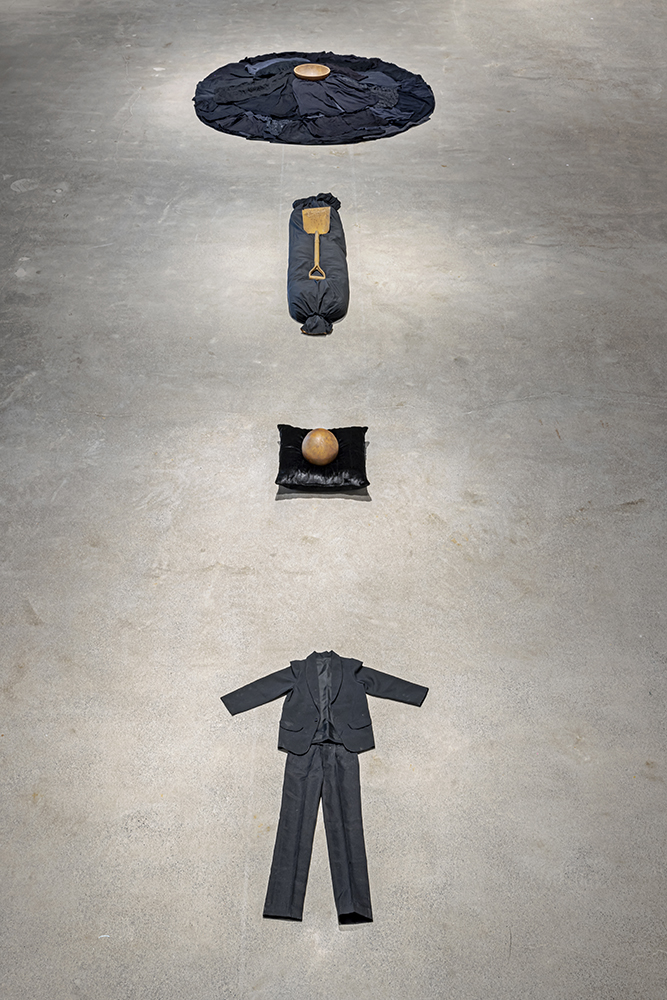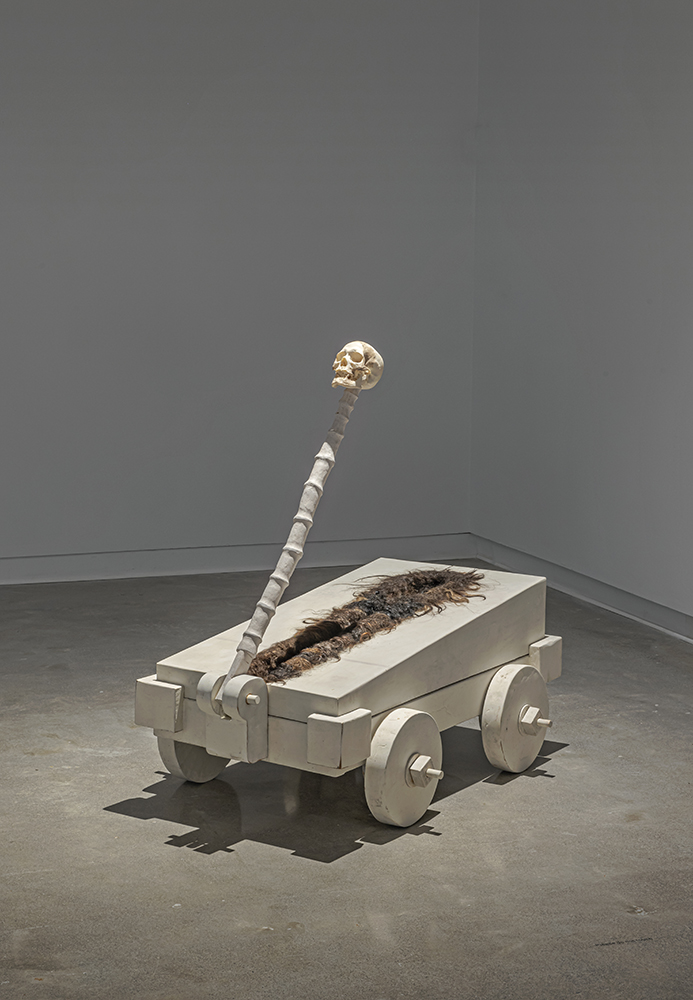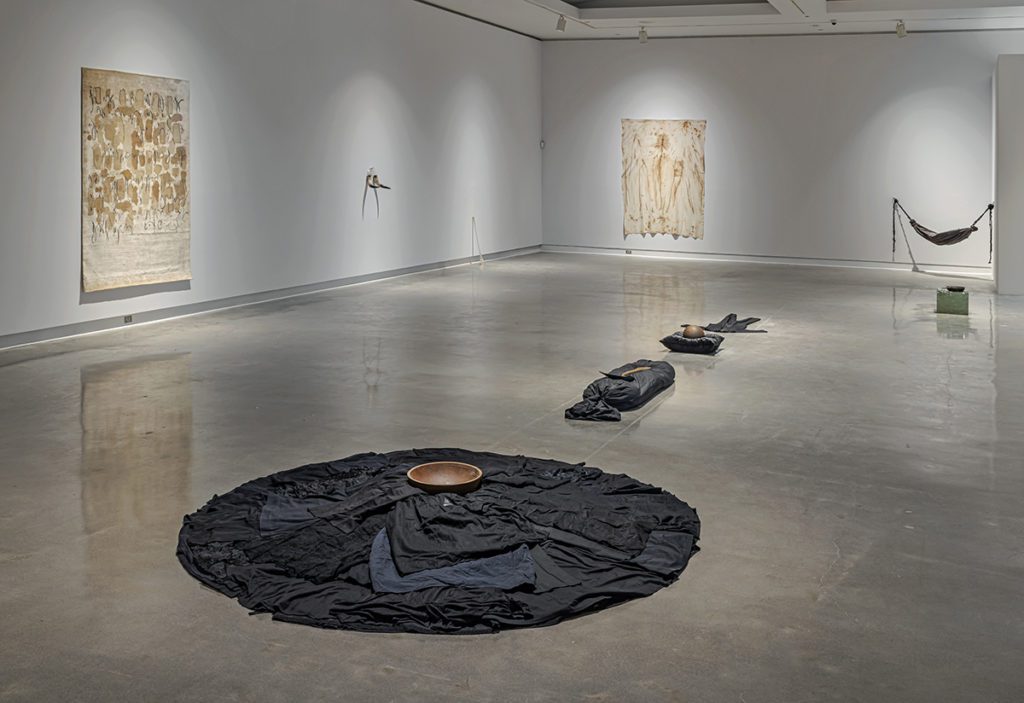Elemental: Oceanic at The Robert McLaughlin Gallery
1 November 2022By Ricky Varghese

Keralites are a chronically melancholic sort of people. I should know; I am one. How could you not be when you hail from a 600-kilometre-long thin strip of tenuous horizon, where a violent blue sea, a lush, verdant land, and the hot pinkish-hued sky all meet—pushing against the very limits of our capacities for perception, experience and overall interestedness in matters of living and dying? I learned a little something about living and dying on that coast of the Arabian Sea when I used to spend childhood summers visiting family in Kerala. The mythological origins of the land are well-rehearsed, especially among scholars of Hindu philosophy and mysticism—the warrior sage Parasurama, the sixth avatar of Lord Vishnu, threw his axe across the sea and when he did so, the water began to recede as far as it reached. This strip of land, Parasurama Kshteram (Parasurama’s Land), borne of the anger of an old man directed at the sea, would come to be known as modern-day Kerala. A tale as old as anachronistic time itself, about an old man and the sea, one that even predates Hemingway’s melancholic novel.
My maternal grandfather—neither Hindu nor a philosopher, but a communist and a farmer, fed on a healthy diet of both Marx and mythology—would revise the story of the birth of Kerala for me and his other grandchildren. He would instead suggest that it is not Parasurama who birthed Kerala by wielding his axe across the sea, thus giving it an unsolicited caesarean section (the sea figures quite prominently in the long tradition of Malayalam prose and poetry and is more often than not gendered female). Rather, Kerala was what the sea did not want, what the sea threw back up. My grandfather would say, in his Malayalam inflected with a thick inland Idukki-accent, “…we owe our very existence to our rejection…this is what makes us, Keralites, the saddest people on earth…we were unwanted from the very beginning.” The tenuousness of this horizon, which I alluded to earlier, was felt all the more acutely when back in August 2018 as a result of the largest rainfall to hit Kerala in a century’s time, the state’s otherwise well-developed infrastructure came close to being eviscerated. With the ever-present pressures of climate change always already looming on that horizon, it was as though during those floods the sea had finally returned to take back what belonged to it.

Years after those heady, hot summers spent on the coast, I would hear an echo of my grandfather’s tragic sentiment on—of all places—an episode of a food and travel television show hosted by Anthony Bourdain called No Reservations. In this particular episode, which aired in 2012, Bourdain is showing his viewers around the port city of Lisbon. In one segment of this episode, we find our host in what appears to be a dive bar listening to music, accompanied by the famous Portuguese writer António Lobo Antunes and the fado singer Carminho. Antunes, who lived through the brutal dictatorship of the Salazar regime, is cynical in his response to Bourdain’s wide-eyed American travel-bug-infected inquisitiveness about Portugal. In a moment of painful temerity, the writer says to his all too eager listener: “Sometimes I wonder if Portugal is not what the sea doesn’t want.” Carminho, though of a significantly younger generation than her companions, turns to Bourdain and says, taking her cue from Antunes’s remark, “Portuguese people are not so positive…” In that moment when I heard this, I thought to myself—is this what Sigmund Freud meant when he wrote about the experience of the uncanny, that species of the familiar in how we experience and encounter the world around us, that is so familiar to something we have long known, perhaps all too familiar such that it inspires a kind of undoing, a kind of fear, in us? Is it, then, a case of the uncanny that the Portuguese explorer Vasco da Gama set sail in search of a sea route to India, landing in 1498 on the coast of Kerala? Did he, the colonist, see in the people he would eventually open the doors tobe subjugated to a shared humanity? Did he recognize in them a people, not unlike his own, who were unwanted and rejected by the sea? Perhaps, the oceanic is, at its core, the very definition of the uncanny.
I decided to begin this review of Elemental: Oceanic by way of this circuitous and meandering personal and historical reflection for two reasons. Firstly, as a writer influenced by psychoanalytic thinking, I approach the work of criticism in what I would hope is a thoroughly free associative manner. I like to wander in and out of an experience with a work of art or an exhibition, allowing the experience to wash over me, impacting my affects and pushing my sense memories in surprisingly unexpected directions. Secondly—and this is not in the least bit unrelated to the first reason—I wanted to take seriously what Tim Whiten himself stated in a recently recorded exchange with the artist Erika DeFreitas about what he hoped for in how people experience his work: “The work is the work…there’s no way one can interpret [it]…and the reasons that I try to stress that for people is usually they always want you to explain things away…and I’m not interested in doing that. I’m not committed to it…if people actually experience the work, they will take away what they need.”1 The work of criticism, then, is not merely a descriptive task where the artwork becomes reduced or flattened down to how it may be explained or written about—either technically or regarding the aesthetic choices that were made by the artist. Rather, the work of criticism here bears itself as an opening for an experience, in this case of the oceanic as a state of subjectivity or subject formation and, possibly, even a state of shared humanity. And still further, more than just an experience: perhaps the work of criticism could offer itself up here as a heuristic encounter between artist and viewer, or artist and writer; a sharing, as alluded to earlier, of that which is human, perhaps all too human.

There is no question that Whiten’s and my reference points, our historical trajectories, our psychical investments and memory associations, and our biographies differ, and perhaps differ quite starkly. However, as I was walking through this exhibition—the first of a four-part, multi-venue retrospective celebrating the artist’s career developed in partnership between the Art Gallery of Peterborough, Art Gallery of York University, Robert McLaughlin Gallery, and the McMaster Museum of Art—my thoughts, almost instinctually, took me on a voyage back to Kerala and the childhood summers I spent on that tenuous coast. Thoughtfully curated by the deft hands of Leila Timmins, this first iteration of the Whiten retrospective at the Robert McLaughlin Gallery feels simultaneously like a combination of both the study for a work of visual poetry and a blueprint for the artist’s own complex memory palace. Despite containing works produced as early as in the 1970s to the present, the entire curatorial effort shows in Whiten’s thought process a contiguous approach: in how they have been placed, in how the light falls on them, each work is given primacy over every other work, and yet in spite of appearing as works of art that appear to stand alone, both against one another and to the tests of time and labour, and of memory and history. The works stand as testaments to how the artist considers the questions of ritual, citation, iteration, historical memory, ancestral trauma, and remembrance as central to his practice. The end result, pun-intended, is simultaneously oceanic and uncanny. Uncanny, because it inspired in this viewer a flurry of memories and associations from an elsewhere place, from a different geography and an altogether different time. Oceanic, because of what the exhibition offers, an encounter with the gesture of sharing, which I will distinguish from the act of appropriating.
It is fairly well-known in psychoanalytic circles that the phrase “oceanic feeling” was first coined by the French dramatist and mystic Romain Roland in a letter he penned to Freud in 1927.2 Roland, himself compelled to understand the experience of spiritual ecstasy felt by the Hindu mystic Ramakrishna, implored Freud to analyze the role of spiritual experiences in the latter’s psychological studies. For Roland, following Ramakrishna, the oceanic feeling is a feeling of the eternal, or the feeling of oneness—a kind of contiguity—with the world around us. Freud, for his part, would take up Roland’s challenge and briefly attend to exploring this oceanic feeling in both The Future of an Illusion and Civilization and Its Discontents. Freud was admittedly suspicious of the spiritual and overly religious. It is not that he had no use for these categories, rather he wanted to understand unconscious processes in a somewhat more scientific manner. Accordingly, for him the oceanic feeling was what one might observe as a kind of primitive-ego feeling in infants. As a primitive-ego feeling, it precedes ego formation. What is meant by this is that in the infant, this manifests as a sense of oneness with its surroundings, most immediately with the mother’s breast. In this scene, as a primitive-ego, the infant has not yet developed the capacity to distinguish between itself and others. The breast is seen as always readily available to respond to the infant’s hunger. Separation, individuation, distinction, otherness, and what it means to depend on others —in this case, the maternal—have not yet been experienced, and the birth of the ego in the child coincides with the child breaking free of the oneness it feels with its surroundings. The oceanic is unity personified—a horizon with no end in sight, endless, overflowing, all-consuming, all-absorbing, all-incorporating.

As can be seen in the programming description for Elemental: Oceanic, a chief takeaway for the viewer is that by “referencing the cyclical nature of life, the work is a reminder that to live with the remembrance of death is to live fully and expansively.” Living and dying, as envisaged by this exhibition, are contiguous, oceanic and uncanny sides of the same coin. Living and dying are part of the shared humanity that Whiten’s work seems to attend to, and that in me evoked a particular set of memories that felt simultaneously both connected to, and disparate from, the artist’s own reference points. Sharing is distinguished here from appropriation because of what sharing as a relational gesture evokes in both the artist and the viewer. The oceanic is not a universal category, rather, it is subjective, personal, and deeply intimate, both for the artist and the viewer. It is not that I impose my narrative strands on the artist’s intentions, nor that the artist expects me to walk away from his objects having learned something of his intentions. Instead, in the spirit of the oceanic, as a contiguous feeling of oneness with the world, our intentions and experiences may brush up against each other, they may have their borders touch up against each other. Is this not what it means to be responsible, mature, and ethical in the world?
Walking through the exhibition inadvertently took me to an elsewhere place, distant both in terms of geography and temporality. Elemental: Oceanic shows how a nearly four-decade career has grown and matured. It is this sense of maturity that I found incredibly enlivening, to the extent that I had to ask myself—had I matured myself, as a writer or thinker? What would it mean to mature, to finally be responsible for and to one’s practice as either a writer or an artist? Perhaps to mature in one’s practice is akin to what Jacques Derrida, in his final interview, suggested about what it means to learn to finally live:
Apprendre à vivre means to mature, but also to educate: to teach someone else and especially oneself. When you address someone and say “je vais t’apprendre à vivre,” it sometimes has a threatening tone, meaning not only “I am going to teach you how to live” but “I’m going to teach you a lesson,” “I’m going to get you to shape up or whip you into shape.” From there—and the ambiguity of this play is even more important to me—this sigh leads to a more difficult question: is living something that can be learned? or taught? Can one learn, through discipline or apprenticeship, through experience or experimentation, to accept or better, to affirm life? This concern for legacy and death resonates…[It] is also something that torments parents and their children: “When will you become responsible? How will you answer or finally take responsibility for your life and for your name?”3

In the revised story that my grandfather told me, perhaps he was attempting to offer me a lesson in mortality, in what it means to live on the edge, not merely of a literal coast, but on the edge between life and death. It certainly felt to me that with Elemental: Oceanic, Whiten was also letting us know that he has learned what it means to answer and take responsibility for a practice that revisits this precipice time and again. Maybe what is uncanny about the oceanic, is not that it is uncanny at all, but that it is quite possibly, in the final analysis, so incredibly ordinary in how human it is, and how this reminds us of our fragile humanity. Is this reminder, then, not a call, nay a demand, to be responsible, ethical and mature in relation to the world we inhabit?
- McMaster Museum, “Tim Whiten in conversation with Erika DeFreitas,” May 6, 2022, video, https://www.youtube.com/watch?v=5XvnzJAP1TM
- Henri Vermorel and Madeleine Vermorel eds, Sigmund Freud et Rolland Romain: Correspondance 1923-1936. (Paris: Presses Universitaires de France, 1993).
- Jacques Derrida and Jean Birnbaum, Learning to Live Finally: The Last Interview. (Hoboken, NJ: Melville House Publishing, 2007).
Elemental: Oceanic ran from April 9 – August 28, 2022 at The Robert McLaughlin Gallery in Oshawa, ON.
Feature Image: Installation view of Elemental: Oceanic by Tim Whiten. Photo by Toni Hafkenscheid courtesy of The Robert McLaughlin Gallery.



